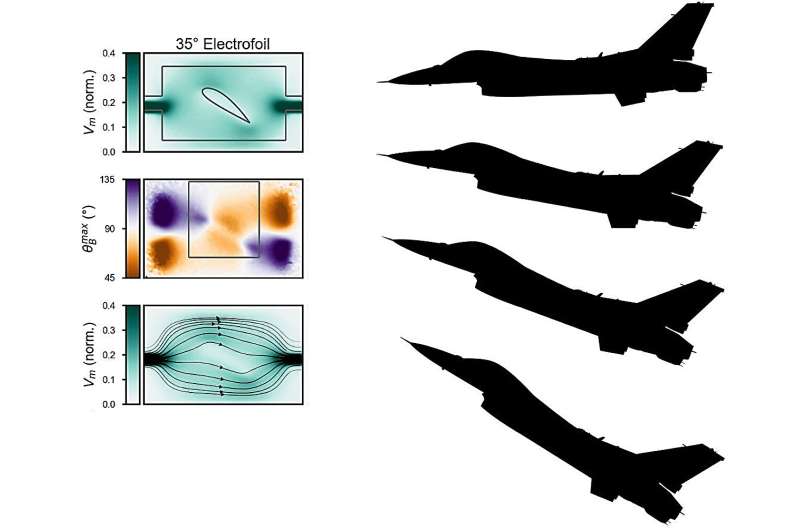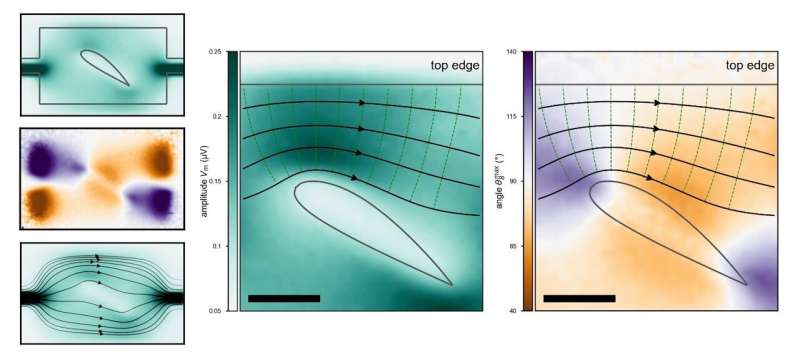This article has been reviewed according to Science X's editorial process and policies. Editors have highlighted the following attributes while ensuring the content's credibility:
fact-checked
peer-reviewed publication
trusted source
proofread
Visualizing electron flow motivates new nanoscale devices inspired by airplane wings

A study showing how electrons flow around sharp bends, such as those found in integrated circuits, has the potential to improve how these circuits, commonly used in electronic and optoelectronic devices, are designed.
It has been known theoretically for about 80 years that when electrons travel around bends, they tend to heat up because their flow lines get squished locally. Until now, however, no one had measured the heat, for which imaging the flow lines is first needed.
The research team, led by Nathaniel M. Gabor at the University of California, Riverside, imaged streamlines of electric current by designing an "electrofoil," a new type of device that allows for the contortion, compression, and expansion of streamlines of electric currents in the same way airplane wings contort, compress, and expand the flow of air.
"Electric charge moves similarly to how air flows over the surface of an airplane wing," said Gabor, a professor of physics and astronomy. "While it is easy to image the flow of air by using, say, streams of smoke or steam in a wind tunnel, as often seen in car commercials, imaging the streamlines of electric currents is far more difficult."
Gabor said the team combined laser imaging with novel light-sensitive devices to come up with the first images of photocurrent streamlines through a working device. A photocurrent is an electric current induced by the action of light.
"If you know how the electrons are flowing you can then know how to prevent them causing deleterious effects, such as heating up the circuit," Gabor said. "With our technique, you can now assess exactly where and how the electrons are flowing, giving us a powerful tool to visualize, characterize, and measure charge flow in optoelectronic devices."
The research paper is titled "Mapping the intrinsic photocurrent streamlines through micromagnetic heterostructure devices" and appears in the Proceedings of the National Academy of Sciences.
Gabor explained that when electrons gain kinetic energy they heat up. Ultimately, they heat the material around them, such as wires that can risk melting.
"If you get a heat spike in your computer, your circuits start to die," he said. "This is why when our computers overheat, they shut off. It's to protect circuits that could get damaged because of all the heat being dissipated in the metals."

Gabor's team designed the electrofoils in the lab as little wing shapes in nanoscale devices that make the electrons flow around them, similar to how air molecules flow around an airplane wing.
"We wanted a shape that could give us different rates of turning, something with a continuous curvature to it," Gabor said.
"We took inspiration from airplane wings, which have a gradual curve. We forced the current to flow around the electrofoil, which offers different angles of flight. The sharper the angle, the more the compression of the flow lines. In more and more materials, we are starting to find that electrons behave like liquids. So rather than design devices based on, say, electrical resistance, we can adopt an approach with plumbing in mind and design pipelines for electrons to flow through."
In their experiments, Gabor and his colleagues used a microscopy method that employs a uniform rotating magnetic field to image photocurrent streamlines through ultrathin devices made of a layer of platinum on yttrium iron garnet, or YIG. YIG is an insulator but allows for a magnetic field effect when a thin layer of platinum is glued to it.
"The magnetic field effect shows up only at the interface of this garnet crystal and platinum," Gabor said. "If you can control the magnetic field, you control the current."
To generate a photocurrent in a desired direction, the researchers directed a laser beam on YIG, with the laser serving as a local heat source. An effect known as the "photo-Nernst effect" generates the photocurrent whose direction is controlled by the external magnetic field.
"Direct imaging to track photocurrent streamlines in quantum optoelectronic devices remains a key challenge in understanding exotic device behavior," Gabor said. "Our experiments show that photocurrent streamline microscopy is a robust new experimental tool to visualize a photocurrent in quantum materials. This tool helps us look at how electrons behave badly."
Gabor explained that it is well known that electrons behave in "weird ways" under specific conditions, especially in very small devices.
"Our technique can now be used to better study them," he said. "If I was trying to design an integrated circuit and wanted to know where heat might originate in it, I would want to know where the current flow lines are being squeezed. Our technique can help design circuits and estimate what to avoid and suggests you should not have sharp bends in your wires. Wires should be gradually curved. But that is not the state of the art right now."
More information: David Mayes et al, Mapping the intrinsic photocurrent streamlines through micromagnetic heterostructure devices, Proceedings of the National Academy of Sciences (2023). DOI: 10.1073/pnas.2221815120
Journal information: Proceedings of the National Academy of Sciences
Provided by University of California - Riverside





















